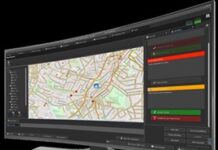
A new piece of German technology can be used to clearly identify vehicles and pave the way for new opportunities in digital traffic management. The new RFID-based system uses contactless and automated technology to identify cars in still and moving traffic. This consists of a vehicle licence plate (Id-e-Plate) and windscreen sticker (Id-e-Stix). Both contain a passive chip with a saved and encrypted identification number.
The United Nations has classified Tokyo, Delhi and Shanghai as the most heavily populated cities in the world. Economic growth in Asian regions is attracting lots of people from provinces to metropolitan centres. This is happening too quickly for the infrastructure to deal with. Overcrowded streets are causing congestion, air pollution and accidents. Smart management and vehicle recognition systems must get this chaos under control in the future. After all, not all vehicles can fit onto the streets at the same time.
With the new system, authorised readers receive the encrypted identification number and compare it against the vehicle register. As the number receives a different encoding and encryption every time it is read, tracking is not possible. The database can only be accessed by the authorities. All vehicles in the metropolis of Manila and the rest of the Philippines are already fitted with the Id-e-Stix; cars carry it on their windshield, while mopeds display it on their headlamp (Headlamp-tag).
The Chinese state authorities use licence plates to establish which cars are allowed to drive at certain times. This is determined by the last digit, which is either odd or even. “This method is pragmatic but hard to monitor”, explains Dietmar Mönning, Managing Director of Tönnjes E.A.S.T. The Id-e-Plate system would be a sensible alternative. The merely optical features used to restrict access in China can be bypassed by manipulating number plates. “Fraudsters might attach stolen licence plates to their car to match the required digit”. Wealthy people buy several cars to get past the regulation.
1,200 new vehicles are introduced every day in Delhi, India. And this has an impact on the air: According to a medical investigation carried out by Delhi’s traffic police last year, one in seven people suffer from respiratory diseases. “It is questionable whether the metropolitan region even has an intact vehicle owner register”, states Mönning. This forms the basis for potential traffic management and access control systems to reduce the region’s carbon footprint. Tönnjes E.A.S.T. has supported Nairobi’s authorities with the creation of a central register and delivered Id-e-Stix for all vehicles in Kenya.
Cities only make up 2% of the world’s surface but, according to the Frauenhofer Institute, they account for 80% of global CO2 production. Over half of the world’s population now live in metropolitan centres and have to travel around in the most congested of conditions. “Several megacities are faced with the prospect of a transport system collapse if they fail to act soon”, says Mönning. Vehicle registers, access controls and management systems could be the answer.
Given the high amount of people and vehicles, however, an efficient method is required with modules to adapt to local requirements. “Our IDePLATE system can be used in many ways to clearly identify vehicles and take the burden off states and public authorities; unlike optical recognition methods, the Id–Plate hardly requires any staff. The system also protects against manipulation, theft and misuse, as its optical and electronic security features like watermarks, holograms and digital signatures make forgery impossible











